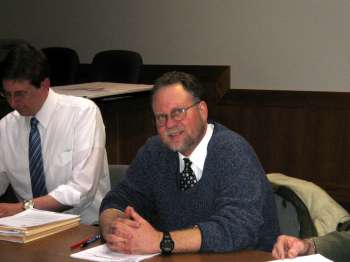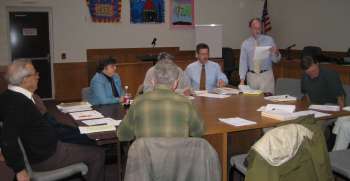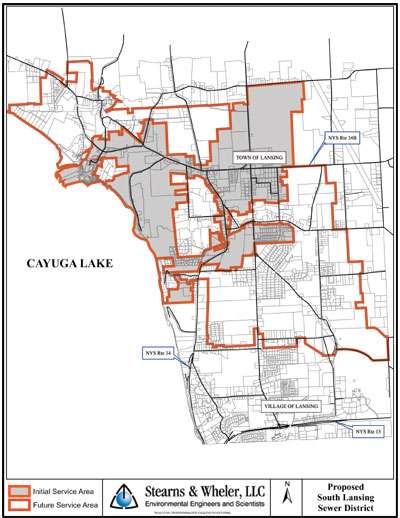- By Dan Veaner
- News
 Print
Print
Department of Environmental Conservation (DEC) Regional Water Engineer Steve Eidt told Lansing Town and Village officials Wednesday that the DEC strongly supports their regional approach to sewer treatment. Eidt was invited to Wednesday's Town Sewer Committee meeting to clarify the DEC's stand on Lansing sewer issues and Cayuga Lake conservation. "We're 100% behind the project," he told the committee. "We fought very hard to get the funding you received from the bond act. We still strongly support the proposal for a regionalized approach."

Engineer Jim blum (left) and DEC Regional Water Engineer Steve Eidt (right)
As the Town of Lansing moves closer to building its sewer, residents and local officials have raised questions about the particular way it is being planned. Questions have been raised about the wisdom of pumping effluent through the Village to the Southern part of Cayuga Lake where the Cayuga Heights Treatment Plant is located. Residents are concerned, because the current runs from south to north along the eastern shore that includes 14 miles of Lansing lakefront. Some residents have called for another look at a stand-alone treatment plant in the Town, located as far north as possible.
But Eidt said that treating the effluent at the Cayuga Heights plant will mean discharging less phosphorus into the lake, because larger plants have more funding and oversight to reduce it. "You will be adding phosphorus into the system down there," he said, "but the treatment will be so improved as roughly an 80% reduction of phosphorus from all the point sources. By bringing your waste water into (the Cayuga Heights treatment plant) we are actually able to reduce the amount of phosphorus that goes into the southern end of the lake from the point sources."
The recommended standard for releasing phosphors into Cayuga Lake is 20 micrograms per liter. ""We have other lakes that have 40 micrograms per liter," Eidt said. "One of our favorite lakes by Syracuse goes up to 140 and 180 at times. Here we're looking at the range of 17, 23, 24. So it's entirely different in scope of how close it is to being at that guidance value of 20." He said that rain storms raise the inflow of phosphorus into the lake far more than treated sewer water.
Eidt said the DEC prefers larger regional plants, because they are easier to regulate. "When you add another small treatment plant you run into a number of issues," he said. Poor or old sewer systems require more attention to the inflow infiltration than the plant may be able to handle. Additionally there is significantly more non-compliance with DEC regulations at smaller facilities. "That's a big issue with us," he told the committee. "Everybody always expects that there's a cheaper alternative, but what we find in the end is it becomes more limiting to growth more quickly." He said it is harder to add on or upgrade smaller plants, with the result that costs are higher and compliance is lost.

Sewer Committee. Chairman Bud Shattuck isstanding.
Eidt noted there was strong incentive in the bond act to use a regional approach. Of the $25 million available for the Finger Lakes the "Group of Six" (City and Town of Ithaca, the Town of Dryden, Cayuga Heights and the Village and Town of Lansing) got more than 50% of the money because they agreed to share processing plants. He said that funding for the trunk line is virtually unheard of, but was granted to the Lansing project because of the regional approach.
Eidt said, "There are a lot of dynamic things in the ecosystem that change lakes." He urged local officials to support a new phosphorus ban in dish washing detergents that is going before the legislature. "Zebra muscles also helped an awful lot in a lot of our lakes," he said.
If Lansing were to change course and build a stand-alone plant it could stand to lose $4,883.000 of bond act money that was granted with the regional approach in mind. "The original application was scored on the basis of municipal cooperation," said Eidt. He said that he checked earlier Wednesday with officials in Albany to make sure and they confirmed that if the project were to change course and build a stand-alone plant the money would go back into the fund where municipalities across the State are competing aggressively for it. "There are a lot of projects out there looking for that money," Eidt said.
The money could be in jeopardy anyway, because it has taken so long to get the project going. Eidt strongly recommended that the Town develop a work plan and get contracts signed as soon as possible to insure the money won't be withdrawn. The Ithaca and Cayuga Heights plant have already used some of the bond act money to upgrade their system to better filter phosphors. Eidt said the money spent on the treatment plants will not be in question if Lansing builds a stand-alone plant. "It would not change for them," he said. "The impact would be to you."
"We really believe the regionalized approach is the right approach," Eidt said. "In the long term it will allow the best things not only for the whole region, but also for the Village of Lansing and the Town of Lansing."
In other business, engineer Jim Blum presented the committee with maps showing a draft of the proposed sewer district. They make a first pass at defining the boundaries of the whole district, and show regions within the area that will be serviced first and others that the sewer will expand to in the future. He also outlined a schedule for public education on the project, saying that public meetings are intended for June and July of this year. By that time all the details on the cost and scope of the project should be defined.
Town Supervisor Steve Farkas reported that the "Group of Six" is negotiating treatment rates, which will also affect the amount charged to district residents. Village Mayor Don Hartill noted that part of the cost the plants are asking for covers using their transmission systems. "The Village uses little of that system," he said, " and the Town uses none of it." Farkas said that representatives from all six municipalities would have to be involved in the negotiation.
Hartill reported that a traffic study on Route 34 is complete, and showed copies to Town officials and committee members. He hopes to use it to convince the Department of Transportation (DOT) that traffic could detour onto Triphammer Road, so DOT requirements for constructing the sewer along State roads will be waived. Those requirements raise the cost of that route about a half a million dollars higher that of building the sewer on Cayuga Heights Road. The Village has expressed its preference for Route 34, but anticipating that costs will not be brought into line the Town has begun engineering for the other route. Sewer Committee Chairman Bud Shattuck told the Mayor, "Nothing's etched in stone yet, but it will be soon. We've got a timetable for moving it forward."
----
v2i12

Engineer Jim blum (left) and DEC Regional Water Engineer Steve Eidt (right)
As the Town of Lansing moves closer to building its sewer, residents and local officials have raised questions about the particular way it is being planned. Questions have been raised about the wisdom of pumping effluent through the Village to the Southern part of Cayuga Lake where the Cayuga Heights Treatment Plant is located. Residents are concerned, because the current runs from south to north along the eastern shore that includes 14 miles of Lansing lakefront. Some residents have called for another look at a stand-alone treatment plant in the Town, located as far north as possible.
But Eidt said that treating the effluent at the Cayuga Heights plant will mean discharging less phosphorus into the lake, because larger plants have more funding and oversight to reduce it. "You will be adding phosphorus into the system down there," he said, "but the treatment will be so improved as roughly an 80% reduction of phosphorus from all the point sources. By bringing your waste water into (the Cayuga Heights treatment plant) we are actually able to reduce the amount of phosphorus that goes into the southern end of the lake from the point sources."
The recommended standard for releasing phosphors into Cayuga Lake is 20 micrograms per liter. ""We have other lakes that have 40 micrograms per liter," Eidt said. "One of our favorite lakes by Syracuse goes up to 140 and 180 at times. Here we're looking at the range of 17, 23, 24. So it's entirely different in scope of how close it is to being at that guidance value of 20." He said that rain storms raise the inflow of phosphorus into the lake far more than treated sewer water.
Eidt said the DEC prefers larger regional plants, because they are easier to regulate. "When you add another small treatment plant you run into a number of issues," he said. Poor or old sewer systems require more attention to the inflow infiltration than the plant may be able to handle. Additionally there is significantly more non-compliance with DEC regulations at smaller facilities. "That's a big issue with us," he told the committee. "Everybody always expects that there's a cheaper alternative, but what we find in the end is it becomes more limiting to growth more quickly." He said it is harder to add on or upgrade smaller plants, with the result that costs are higher and compliance is lost.

Sewer Committee. Chairman Bud Shattuck isstanding.
Eidt noted there was strong incentive in the bond act to use a regional approach. Of the $25 million available for the Finger Lakes the "Group of Six" (City and Town of Ithaca, the Town of Dryden, Cayuga Heights and the Village and Town of Lansing) got more than 50% of the money because they agreed to share processing plants. He said that funding for the trunk line is virtually unheard of, but was granted to the Lansing project because of the regional approach.
Eidt said, "There are a lot of dynamic things in the ecosystem that change lakes." He urged local officials to support a new phosphorus ban in dish washing detergents that is going before the legislature. "Zebra muscles also helped an awful lot in a lot of our lakes," he said.
If Lansing were to change course and build a stand-alone plant it could stand to lose $4,883.000 of bond act money that was granted with the regional approach in mind. "The original application was scored on the basis of municipal cooperation," said Eidt. He said that he checked earlier Wednesday with officials in Albany to make sure and they confirmed that if the project were to change course and build a stand-alone plant the money would go back into the fund where municipalities across the State are competing aggressively for it. "There are a lot of projects out there looking for that money," Eidt said.
The money could be in jeopardy anyway, because it has taken so long to get the project going. Eidt strongly recommended that the Town develop a work plan and get contracts signed as soon as possible to insure the money won't be withdrawn. The Ithaca and Cayuga Heights plant have already used some of the bond act money to upgrade their system to better filter phosphors. Eidt said the money spent on the treatment plants will not be in question if Lansing builds a stand-alone plant. "It would not change for them," he said. "The impact would be to you."
"We really believe the regionalized approach is the right approach," Eidt said. "In the long term it will allow the best things not only for the whole region, but also for the Village of Lansing and the Town of Lansing."
 Initial map of proposed sewer district. Adjustments will be made this Spring to define the final district boundaries. Red lines define the whole district. Shaded areas show initial service areas, while white shows future service areas. |
Town Supervisor Steve Farkas reported that the "Group of Six" is negotiating treatment rates, which will also affect the amount charged to district residents. Village Mayor Don Hartill noted that part of the cost the plants are asking for covers using their transmission systems. "The Village uses little of that system," he said, " and the Town uses none of it." Farkas said that representatives from all six municipalities would have to be involved in the negotiation.
Hartill reported that a traffic study on Route 34 is complete, and showed copies to Town officials and committee members. He hopes to use it to convince the Department of Transportation (DOT) that traffic could detour onto Triphammer Road, so DOT requirements for constructing the sewer along State roads will be waived. Those requirements raise the cost of that route about a half a million dollars higher that of building the sewer on Cayuga Heights Road. The Village has expressed its preference for Route 34, but anticipating that costs will not be brought into line the Town has begun engineering for the other route. Sewer Committee Chairman Bud Shattuck told the Mayor, "Nothing's etched in stone yet, but it will be soon. We've got a timetable for moving it forward."
----
v2i12



